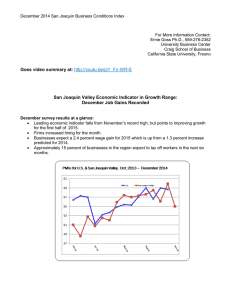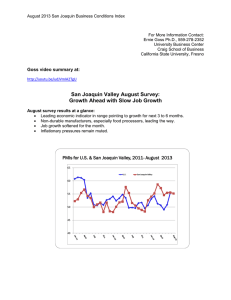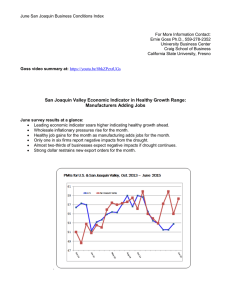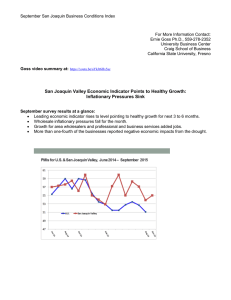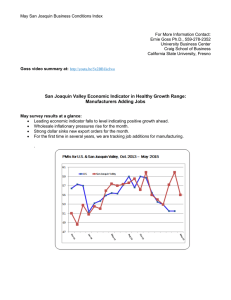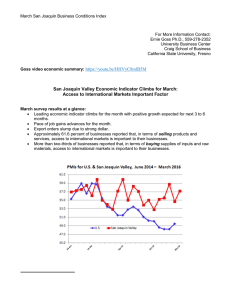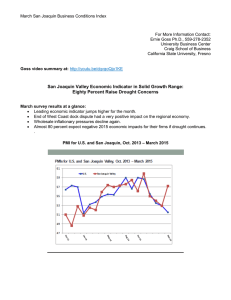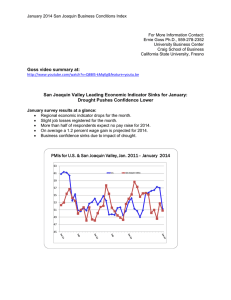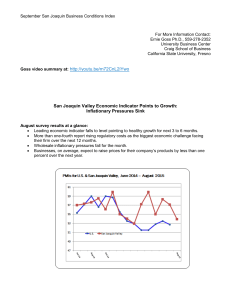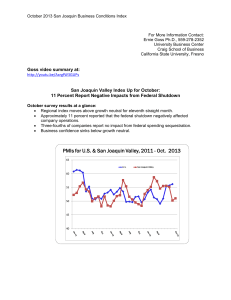Document 13092157
advertisement
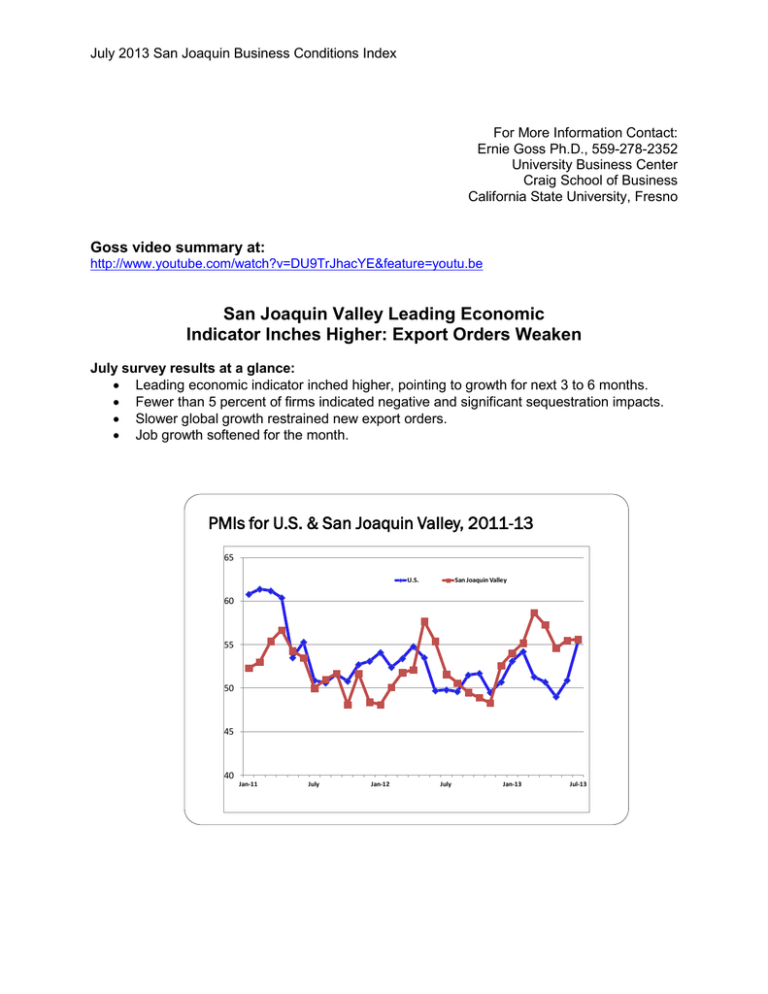
July 2013 San Joaquin Business Conditions Index For More Information Contact: Ernie Goss Ph.D., 559-278-2352 University Business Center Craig School of Business California State University, Fresno Goss video summary at: http://www.youtube.com/watch?v=DU9TrJhacYE&feature=youtu.be San Joaquin Valley Leading Economic Indicator Inches Higher: Export Orders Weaken July survey results at a glance: Leading economic indicator inched higher, pointing to growth for next 3 to 6 months. Fewer than 5 percent of firms indicated negative and significant sequestration impacts. Slower global growth restrained new export orders. Job growth softened for the month. PMIs for U.S. & San Joaquin Valley, 2011-13 65 U.S. San Joaquin Valley 60 55 50 45 40 Jan-11 July Jan-12 July Jan-13 Jul-13 San Joaquin Business Conditions Index – p. 2 of 3 For Immediate Release: August 1, 2013 FRESNO, CA-For the fifth time in the past seven months, the San Joaquin Valley Business Conditions Index expanded, pointing to growth for the next 3 to 6 months. The index is a leading economic indicator from a survey of individuals making company purchasing decisions for firms in the counties of Fresno, Madera, Kings and Tulare. The index is produced using the same methodology as that of the national Institute for Supply Management (www.ism.ws). Overall Index: The index inched higher to 55.6 from 55.5 in June. An index greater than 50 indicates an expansionary economy over the course of the next three to six months. Survey results for the last two months and one year ago are listed in the accompanying table. “The area economy is expanding but at a slow pace. Construction firms and wholesalers continue to push growth higher. Even so, construction activity remains well below pre-recession levels even as growth improves for this important industry. This has been a real boost for the San Joaquin economy,” said Ernie Goss, Ph.D., research faculty with the Craig School of Business at California State University, Fresno. Employment: For the ninth straight month, the hiring gauge moved above the growth neutral threshold. The job index fell to a still solid 54.2 from 58.4 in June. Readings over the past several months indicate that the job market has been expanding and will continue to improve. “Even though the four-county metropolitan area is adding jobs at a pace above that of the nation, the employment level is down by approximately 17,000, or 5.5 percent, from prerecession levels. Based on surveys for 2013, I expect the area’s unemployment rate to drop below 10.0 percent by the end of 2013. This will be the first time the region’s jobless rate has dropped below this threshold since 2009,” said Goss. Wholesale Prices: The prices-paid index, which tracks the cost of raw materials and supplies, increased slightly from June’s 58.8 to 58.9 in July. “Wholesale inflationary pressures for the region have trended lower. Weakness in the global economy and the upturn in the value of the dollar have restrained inflationary pressures at the wholesale level. This downward direction in inflationary pressures provides the Federal Reserve (Fed) with flexibility in terms of when they begin tapering their bond buying program (QE3). Even so, I expect the Fed to begin reducing their $85 billion per month bond buying program at their Sept. 17-18 meetings. Business Confidence: Looking ahead six months, economic optimism, captured by the business confidence index, dipped to 50.4 from June’s 50.8. “Higher interest rates and slower global economic growth continue to weigh on the economic outlook,” said Goss. San Joaquin Business Conditions Index – p. 3 of 3 The federal spending sequestration is having very little impact on the outlook. “The last five months, we have asked survey participants how the federal spending sequestration was affecting their company. In the July survey, approximately 85.7 percent of firms indicated that the cuts have had no impact on their company to date. Approximately 9.5 percent in July reported only modest impacts from sequestration. Only 4.8 percent of businesses reported significant impacts. Impacts are rising, but at a very modest pace,” said Goss. Inventories: Businesses reduced inventories for the month. The index sank to 44.6 from June’s 46.8. A pullback in inventory levels is another signal of a downturn in the economic outlook as businesses anticipate slower but positive growth in the months ahead. Trade: The new export order reading slumped to 43.7 from June’s 49.9. At the same time, July’s import reading fell to 47.9 from June’s much stronger 56.6. “Economic pullbacks and slowdowns in Asia and Europe along with increases in the value of the U.S. dollar are having clear negative impacts on sales abroad. The significant decline in the import reading is difficult to interpret given that the area expansion and cheaper prices for foreign goods would be expected to strengthen imports,” said Goss. Other components: Other components of the July Business Conditions Index were new orders at 59.8, up from last month’s 56.6; production or sales at 59.8, up from June’s 58.7; and delivery lead time at 59.5, which is higher than June’s 57.1. Table 1 details survey results for July 2012, June 2013, last month, and July 2013. August survey results will be released on the first business day of next month, September 3. Table 1: Overall and component indices for last 2 months and one year ago (above 50.0 indicates expansion) San Joaquin Valley July 2012 June 2013 July 2013 Leading economic indicator 51.6 55.5 55.6 New orders 43.4 56.6 59.8 Production or sales 42.8 58.7 59.8 Employment 51.3 58.4 54.2 Inventories 60.4 46.8 44.6 Delivery lead time 60.1 57.1 59.5 Wholesale prices 52.9 58.8 58.9 Imports 48.4 56.6 47.9 Export orders 44.6 49.9 43.7 Business confidence 39.5 50.8 50.4 Craig School of Business: http://www.craig.csufresno.edu/ Follow Goss: Twitter at http://twitter.com/erniegoss or www.ernestgoss.com Blog: http://economictrends.blogspot.com
